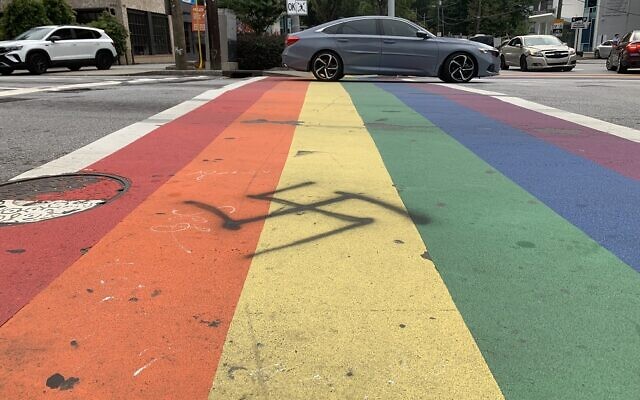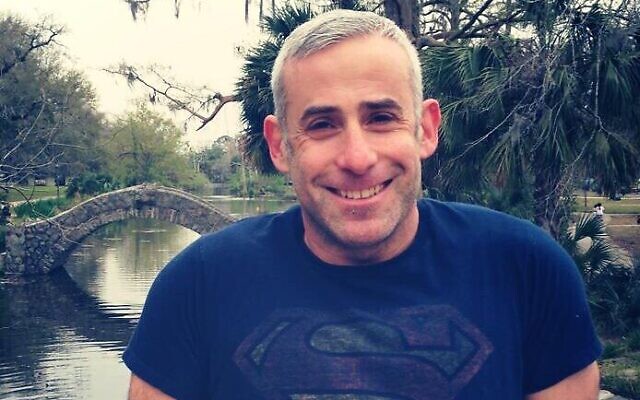Swastika Desecrates Atlanta’s Rainbow Crosswalk
This emblem is a symbol not only of the oppression of Jews during the Holocaust, but also of the LGBTQ+ community.
Dave Schechter is a veteran journalist whose career includes writing and producing reports from Israel and elsewhere in the Middle East.

A swastika spray-painted on the rainbow-colored crosswalks at the intersection of Piedmont Avenue and 10th Street in Atlanta was power-washed away the night of Aug. 17 by a city crew within hours of its discovery.
Police are investigating the vandalism.
A photograph provided to the AJT showed the swastika before its removal. The crosswalks’ color scheme reflects the LGBTQ+ flag: stripes of red, orange, yellow, green, blue and violet.
A statement by Michael Smith, spokesman for Atlanta Mayor Andre Dickens, read: “Atlanta Police immediately notified the Mayor’s Office of the matter, then ATLDOT scrambled a crew — in the rain — to remove the disgusting act of vandalism from our street. We thank the women and men of ATLDOT and APD for erasing the hate that has no place in our city in such a swift and efficient manner.”
A statement issued by the Southeast regional office of the Anti-Defamation League read: “We have been seeing the normalization of hatred and antisemitism seeping into everyday life over the past several years. We are disturbed by this horrible incident which is an unfortunate reminder that we all need to work together to fight hate. Incidents like this serve only to intimidate and harass marginalized communities. We are pleased to see the City of Atlanta take quick action to remove this symbol of hate on the Pride crosswalk at 10th and Piedmont. There is no place for hateful symbols like this in our community. We have reached out to APD to offer assistance in the investigation and to our LGBTQ+ partners to support them and stand in solidarity in fighting hate and bigotry.”

Rabbi Joshua Lesser, rabbi emeritus of Congregation Bet Haverim, is known for his advocacy in both the Jewish and LGBTQ+ communities.
“Seeing a swastika painted on our city’s rainbow crosswalks is distressing as a gay Jewish man,” Lesser told the AJT. “This should be a stark reminder of the need for solidarity when bigotry strikes and seeks to divide. The swastika, seen as a prime symbol of antisemitism, is a signifier of so much more than that. Not only does it represent anti-Jewish and white supremacist points of view, it is also a homophobic and ableist hate symbol. The horror of the Holocaust binds us in our deaths and should be a catalyst today for banding together in support so that we might root out hatred in all forms for life. I am grateful for our Mayor’s swift response and for the people of ATLDOT and APD who worked quickly in the rain to minimize the harm of this offensive act.”
The multicolored crosswalks were installed for the Atlanta Gay Pride Festival in October 2015.
Then-Mayor Kasim Reed announced in 2017 — one year after the mass killing of patrons at a gay nightclub in Orlando — that the rainbow crosswalks would remain, in recognition of Atlanta’s LGBTQ+ community.
Earlier this year, metal plates were installed at the intersection after street racers spun their vehicles there, leaving “donuts” of rubber tread.
During the latter half of August, the city has tested a “pedestrian scramble” traffic light pattern that stops vehicles from all directions, allowing pedestrians to walk diagonally across the intersection.
The swastika — a symbol used independently, and benignly, by many cultures, according to the ADL — was adopted as an emblem by the German Nazi Party in 1920.
After Adolf Hitler took power in Germany in 1933, the swastika became a symbol of oppression, not only of Jews, but also of other minority communities, including homosexuals.
“Gay men, in particular, were subject to harassment, arrest, incarceration and even castration. In Nazi eyes, gay men were weak and unfit to be soldiers, as well as unlikely to have children and thereby contribute to the racial struggle for Aryan dominance,” according to the website of the U.S. Holocaust Memorial Museum.
“Between 5,000 and 15,000 gay men were interned in concentration camps in Nazi Germany,” the website continues. “These prisoners were marked by pink triangle badges and, according to many survivor accounts, were among the most abused groups in the camps.”



comments